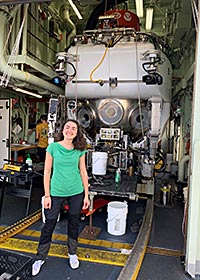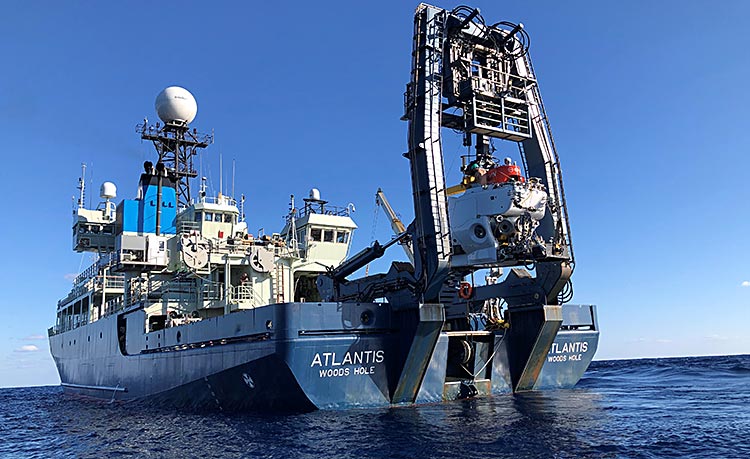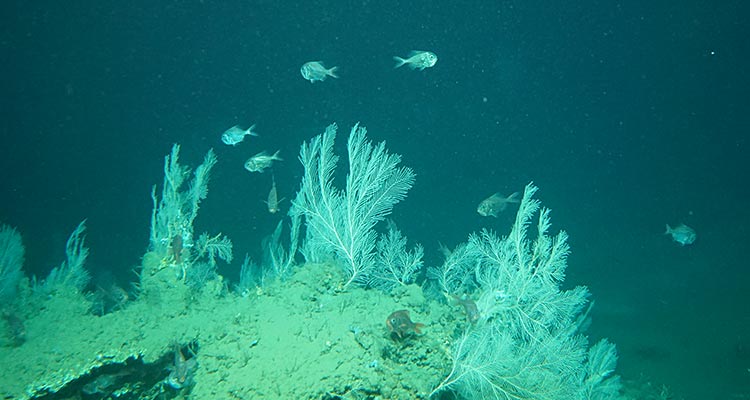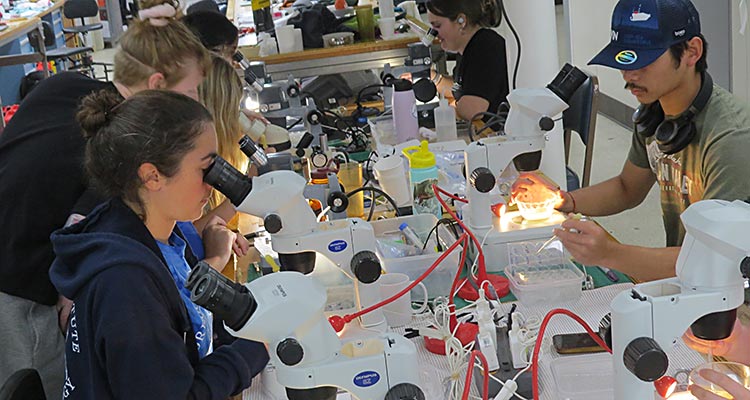Alvin, a 58 years old and famous research submarine plays a key role in helping marine scientists look for answers to crucial questions about deep-sea biodiversity and how far-apart habitats are connected. One researcher from DTU Aqua had the chance to take a close look at the seabed deep down.
Sinja Rist, Postdoc at DTU Aqua, is an ocean scientist who has literally taken her research to a new level – more precisely to 500 meters below the sea surface when lately she had the chance to get on the submarine Alvin, a marine research submersible that was on a mission in the Gulf of Mexico and western Atlantic.
In October, Sinja Rist joined the research mission in the waters off Florida - the sampling sites were between 95 km, the one in the Gulf, and 301 km, the one in the Atlantic, from the coast and most of them in a range of 100-250 km. The mission was led by marine scientists from the University of Oregon, Oregon Institute of Marine Biology. It was a deep-sea cruise aimed at studying methane seeps between 300 and 3.300 meters below the sea surface. These areas inhabit unique communities of species that depend on the minerals brought about by the methane.
"Without a real gradient you suddenly find these complex and biodiversity-rich spots with huge tubeworm bushes and mussel beds appear in the midst of the seemingly empty abyssal plane"
Sinja Rist, Postdoc, DTU Aqua
 “These spots are small oases in an environment with extreme pressure and total darkness. Down here, there is no photosynthesis, but there is a very interesting biodiversity,” says Sinja Rist who has now seen it with her own eyes.
“These spots are small oases in an environment with extreme pressure and total darkness. Down here, there is no photosynthesis, but there is a very interesting biodiversity,” says Sinja Rist who has now seen it with her own eyes.
Alvin took Sinja, a research colleague and the submarine pilot down to the seafloor at 500 meters below the surface:
“For me, this was a lifetime experience. Something I had dreamed of as a Bachelor student when seeing the first tiny research submarine but never thought I would get a chance to do,” Sinja says elaborating:
“The time of our dive, around 7 hours in total, passed extremely fast and the inside of Alvin was more comfortable than I expected. We even had a cup of coffee at the seafloor.”
Going deeper with a famous submarine
The main question of the research project, called SALT (Seep Animal Larval Transport) that Sinja took part in when she got on the cruise in the Gulf of Mexico, is:
Since these biodiversity hotspots are so far apart in the deep sea – from the Mexican Gulf to the Atlantic Ocean – how are they connected?
Findings that can answer this key question will contribute to the overall understanding of these unique ecosystems and what is at stake when affected by climate change, pollution and human exploitation.
According to Sinja we don’t know much about the dispersal and the behavior of the animals in these deep seas yet. One way to look at it is to study the larvae of the animals, that means of mussels, snails and tubeworms, as they did on the cruise.
For that purpose, the research ship carries two main instruments: One was the submersible Alvin, and if Alvin could speak, she would have thousands of exciting and famous dives to tell about.
Since 1964, Alvin, owned by the US Navy, has made more than 5.000 dives to observe the lifeforms in the deep sea. Also, Alvin has explored the wreck of Titanic. Research conducted by Alvin has been featured in nearly 2.000 scientific papers. And the trip into the deep with Alvin also opened Sinja Rist’s eyes to a new world:
“It amazed me to see the abundance of life during the whole dive in the water column as well as on the seafloor. Even when it looks empty at first glance, you just need to look closer and you will discover many interesting creatures.”
“It was especially fascinating to see how specialized the community around a methane seep is and how obvious the borders of this habitat are. Without a real gradient you suddenly find these complex and biodiversity-rich spots with huge tubeworm bushes and mussel beds appear in the midst of the seemingly empty abyssal plane,” says Sinja Rist.
The travelling larvae
The other instrument was a so called MOCNESS, a system of nine plankton nets and sensors, which the researchers used to search for the larvae of deep-sea animals throughout the whole water column. This helps to understand in which depth the larvae move and accordingly with which currents they get transported to other habitats.
The deep-sea project is coming to an end next year and will then have lasted for 4 years. Sinja tells that what has so far become clear with this project is that the larvae can travel really far.
They can go almost up to the surface from the deep sea, and they can travel around 1.000 kilometers with the Gulf stream. And these larvae put a lot of energy into the water columns in terms of being food for bigger zooplankton and fish.
The way the larvae disperse is essential for connecting the remote habitats. So, these new findings are essential in understanding ecosystems and habitat mechanisms.
Important research inspiration
Sinja was onboard the cruise for three weeks. Back in Denmark, she will now focus on understanding the larvae in our waters better, especially how they are affected by climate change and pollution.
PHOTO: Top photo taken by the submersible | other photos Sinja Rist



The deep-sea project
SALT involves universities in Oregon, Washington and North Carolina.
DTU Aqua is not officially part of the project, but Sinja Rist spent 8 months as a Postdoc at the Oregon Institute of Biology last year. Insight and data from both the stay and the cruise are decisive elements in her research and in the collaboration with researchers at DTU Aqua.